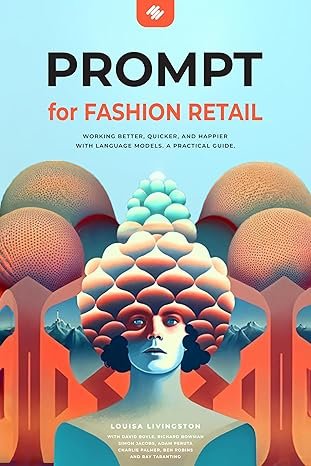
Book Title: PROMPT for Fashion Retail
Authors: The PROMPT Method Team
Publisher: Audience Strategies; 3rd edition
Publication Date: May 18, 2024
Overview
PROMPT for Fashion Retail is a transformative guide that explores the intricate relationship between fashion retail and cutting-edge AI technologies, specifically focusing on the application of prompt-based systems in retail decision-making.
The book highlights how artificial intelligence (AI) can empower fashion retailers to enhance customer experiences, optimize inventory, and respond proactively to market trends.
Structure and Content
The book is organized into several well-defined chapters, each building on core concepts related to AI integration within the fashion industry.
Each chapter dissects critical aspects of AI-driven fashion retail, providing actionable strategies for retailers to embrace technological advancements.
1. Introduction to PROMPT and AI in Fashion
Introductory section lays the groundwork for understanding prompt-based AI systems and their relevance in the modern fashion landscape.
The authors explain how these systems act as a bridge between vast amounts of data and actionable retail insights.
Case studies of fashion giants utilizing AI for inventory management, trend forecasting, and personalized shopping experiences are also presented, setting the stage for practical applications.
2. The PROMPT Methodology
The second section dives into the mechanics of the PROMPT method, outlining how natural language processing (NLP) and machine learning models can analyze vast customer data to generate suggestions, prompts, and insights for fashion retailers.
The authors emphasize the flexibility of this approach, showing how it can be tailored to various segments, from luxury to fast fashion.
3. Customer Personalization and Engagement
This chapter focuses on AI’s ability to revolutionize customer engagement through personalization.
By analyzing consumer behavior, preferences, and previous interactions, AI prompts enable fashion retailers to create hyper-personalized experiences.
This includes tailored product recommendations, personalized marketing campaigns, and even virtual stylists that guide customers in real-time.
The book provides multiple real-life examples of how retailers have successfully used AI to enhance customer loyalty and drive sales.
4. Inventory Management and Supply Chain Optimization
A significant portion of the book is dedicated to showing how AI can optimize inventory management—a critical aspect of fashion retail.
AI-based prompts can analyze historical sales data, predict trends, and ensure that retailers have the right stock at the right time.
This chapter highlights how fashion brands can reduce excess inventory and markdowns while increasing full-price sell-through.
5. Trend Forecasting and Market Adaptability
The book shines in its discussion of AI-driven trend forecasting.
With the fashion industry being highly volatile and trend-dependent, retailers must anticipate shifts in consumer preferences.
The PROMPT method uses data from social media, runway shows, and consumer behavior to forecast trends, enabling retailers to stay ahead of the competition.
This section is particularly valuable for its practical advice on implementing AI-driven trend forecasting systems.
6. Challenges in AI Implementation
While the book is largely optimistic about AI’s potential, it doesn’t shy away from the challenges.
In this section, the authors discuss issues such as data privacy concerns, technological integration barriers, and the costs associated with AI adoption.
These challenges are presented alongside solutions, making it a well-rounded discussion of both the opportunities and obstacles in AI-driven fashion retail.
7. Future Trends in AI for Fashion Retail
The final chapters speculate on the future of AI in fashion retail, covering topics like augmented reality (AR) shopping experiences, AI-powered sustainability efforts, and predictive fashion models that reduce waste.
The authors also touch on the ethical implications of AI, including its impact on jobs and decision-making in fashion.
Strengths of the Book
- Practicality: PROMPT for Fashion Retail excels in offering practical, actionable strategies. Each concept is followed by real-world examples and case studies, making the content not only theoretical but highly applicable to modern fashion retail.
- Comprehensive Coverage: The book covers all major areas where AI intersects with fashion retail, from customer personalization to inventory management. This comprehensive scope ensures that readers gain a holistic understanding of AI’s potential in the industry.
- Clarity and Accessibility: Despite covering a complex topic, the book is written in a clear and accessible manner, making it suitable for fashion professionals who may not have a deep technical background in AI.
- Future-focused: The final section on future trends keeps the reader forward-looking, encouraging retailers to think long-term about how they can continue to evolve in an AI-driven marketplace.
Weaknesses of the Book
- Technical Depth: While the book is accessible, it may not delve deeply enough into the technical aspects of AI for those with a strong technical background. Some readers might find the descriptions of AI algorithms too surface-level and may crave more depth in understanding how the technology works.
- Focus on Larger Retailers: Much of the content seems geared toward larger fashion retailers with significant resources. While there is some mention of how smaller retailers can benefit from AI, more attention could have been paid to the challenges and solutions for smaller businesses.
Conclusion
PROMPT for Fashion Retail is an invaluable resource for fashion retailers looking to embrace AI and digital transformation.
With its blend of strategic insights, practical examples, and a forward-thinking approach, the book equips retailers with the knowledge to stay competitive in a rapidly evolving landscape.
While it has a few limitations in technical depth and small business focus, its overall message is powerful and relevant, offering a clear path for integrating AI into fashion retail.
Recommended For:
- Fashion retailers and executives looking to implement AI-driven strategies.
- Retail professionals interested in digital transformation and staying ahead of trends.
- Those curious about the intersection of technology and fashion retail.
This review captures the essence of the book while offering a balanced analysis of its strengths and weaknesses, ensuring a comprehensive overview for potential readers.


